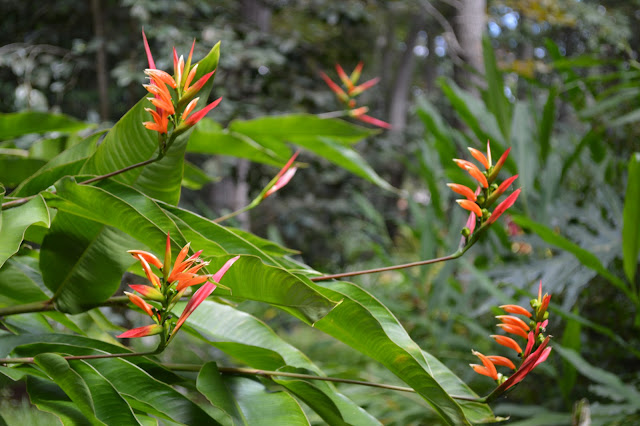Cold Protection for Tropical Plants
 |
| Heliconia hirsuta 'Peru' |
I love using some of the tropical plants in the landscape, even though I live in north Florida where temperatures can dip below freezing several times in the winter. Tropicals hold up so well in our hot humid summers and most add color to the garden well into the fall.
Many tropicals, if damaged by winter freezes, will re-sprout from the roots in the spring and so aren't totally killed by the cold we have in north Florida. However, I am particularly fond of the small-flowering heliconias as shown in the photo above. They will flower on the first season's growth and flower non-stop well into the fall. Related to bananas, with their lush foliage and showy flowers, they add a tropical flair to the garden. Hummingbirds are very attracted to them, so that's an added benefit. They also make excellent, long-lasting cut flowers. But the heliconias don't normally return from the roots in the spring if they are damaged by winter cold. The particular one that I grow multiplies well during the summer, so that means that each winter I have more and more heliconias to protect from the cold.
A few years back I built a small greenhouse. Each winter I would dig the heliconias, place them in large pots, and cram them into the greenhouse. If it got below freezing, I ran a space heater to elevate the temperature inside. But last winter we didn't have a hard freeze and I found that a couple of heliconias that I left outside in the ground came through the winter fine. So, this spring when I brought the heavy pots of heliconias out of the greenhouse, I planted almost all of them in one area. The idea was to simply leave them in the ground this winter and cover them there.
 |
| Heliconias filling greenhouse |
 |
Heliconias planted out this spring
 |
| By October the planting was large and thick. |
|
So... this winter I had to figure out exactly how I would cover the whole planting in case of freeze. I planned to use plastic film, but I needed to be able to either remove it when the temperature wasn't down to freezing, or I needed to provide doors on both ends to provide very good ventilation if I left it in place for the winter. Temperatures can rise to over 100 degrees on a sunny day under the plastic. I searched the internet for ideas and finally found one that I thought would work, would be relatively easy to build, not too expensive, and with some adjustments would allow be the flexibility of putting the plastic film on and off easily, depending on the temperature.
 |
| Here I was starting the assembly of the PVC pipes that would be the frame. One of the primary factors that made this construction relatively easy was the use of the larger pieces of PVC pipe that were driven into the ground to serve as the anchors to hold the frame in place. The smaller PVC pipes that served as the frame could simply be slipped into these anchor pipes to hold them in place. |
 |
| After measuring carefully to determine the height and width needed, I began cutting and assembling the framework on the ground. After gluing it together, I left it so the glue could harden overnight before trying to put it in place. |
 |
| I used 3/4 inch schedule 40 pvc for the framework. A thinner pvc wouldn't have made the bend without snapping. |
 |
| Here it is with the framework inserted into the larger PVC pipe anchors. |
 |
| Note that I left a little extra room on one end where I could insert a space heater on cold nights without there being danger of it being too close to the foliage or plastic film. |
 |
| Here it is with the plastic film pulled over the framework and anchored to the ground with concrete blocks. In reality, I used a few more than shown in this photo. I didn't want heat escaping. |
 |
| The plastic film can be lowered to remain on the ground unless a cold night is expected. Then I pull it up over the framework as soon as the sun has passed over so as to trap the heat from the ground for the night. I also place the space heater inside and adjust the thermostat so that it will switch on as the temperature drops for the night. |
 |
On one night when the temperature dropped to 32 briefly, I pulled the cover up for the night, but with no space heater inside. The temperature under the cover still dropped to 32.7 degrees. This is when I saw that I would have to add the space heater if it really got cold. You can also get an idea of how much the temperature rises under the plastic when the sun comes out the next morning, to 95.6 degrees before I removed it this day, and why you have to be able to remove the cover when it's sunny during the day.
Hopefully my endeavor to protect my heliconias will give you some ideas if you're trying to protect some special tropical plants outdoors through the winter. It may seem like a lot of trouble, but it's worth it when you consider that these plants are difficult to find in north Florida and each individual large plant would probably cost $25 or more in the nursery if I could find it.
David W. Marshall
|








Comments
Post a Comment